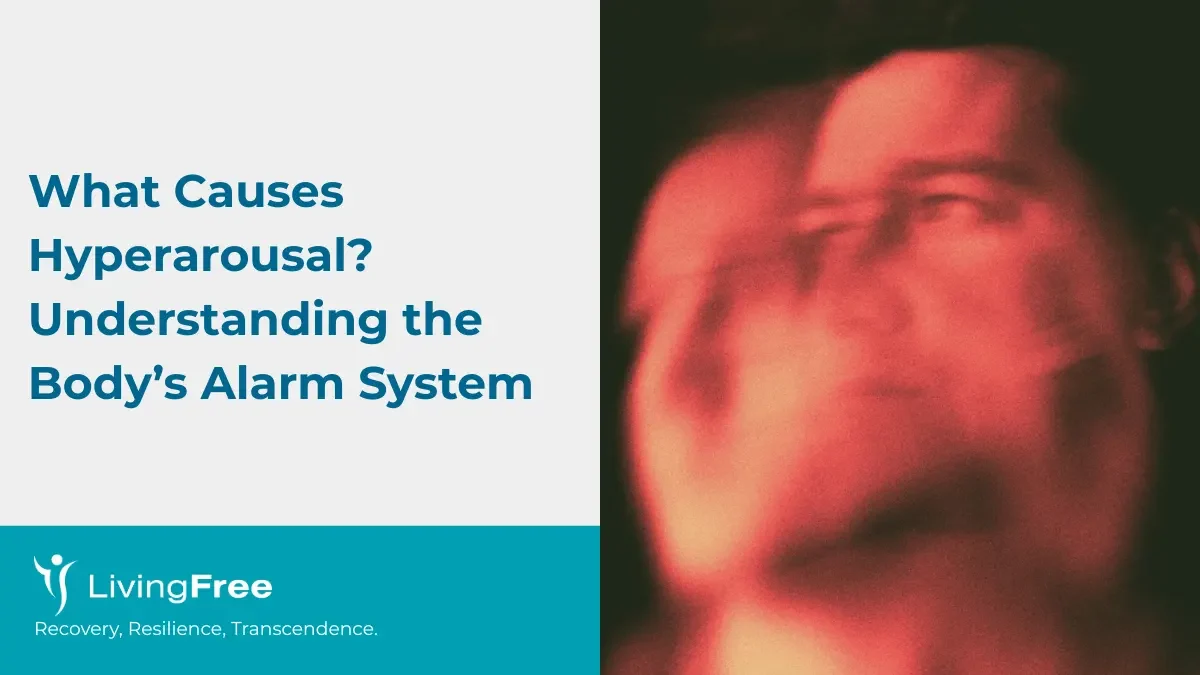Hyperarousal is caused by trauma, chronic stress, and certain mental health and medical conditions. It is a state where the nervous system remains in a “fight or flight” mode, causing a person to stay on high alert even after a threat has passed.
Common causes include Post-Traumatic Stress Disorder (PTSD), anxiety disorders, ADHD, and exposure to trauma such as accidents or abuse. Substance use, like excessive caffeine or nicotine, can also trigger it.
Understanding what causes hyperarousal is essential because it explains why some people feel unsafe, restless, or exhausted even in calm situations.
By exploring what happens inside the body and mind, we can understand why the alarm system stays stuck in survival mode, and how healing begins when the body relearns that safety is possible.
The Body’s Alarm System and How It Becomes Overactive
The human body has a natural defense mechanism designed to protect us from danger.
When the brain perceives a threat, the amygdala signals the hypothalamus to activate the sympathetic nervous system, which prepares the body for action.
Adrenaline and cortisol surge through the bloodstream, heart rate increases, and muscles tense, ready for fight, flight, or freeze.
Normally, when the danger passes, the parasympathetic nervous system calms the body down. In hyperarousal, that “off switch” does not function properly. The body continues to behave as though danger is still present. This constant activation can lead to irritability, insomnia, difficulty concentrating, and a sense of inner restlessness.
1. Trauma-Related Causes
Post-Traumatic Stress Disorder (PTSD)
PTSD is one of the most common and well-documented causes of hyperarousal. It can develop after events such as violence, accidents, natural disasters, or abuse.
In PTSD, the amygdala (the brain’s fear center) becomes overactive, while the hippocampus, which helps distinguish past from present, becomes less active.
The brain’s alarm system remains stuck on high alert, keeping the person in a state of hyper-preparedness. Everyday triggers — a loud sound, a smell, or a certain location — can reignite the feeling of threat as if the trauma were happening again.
Acute Stress Disorder (ASD)
Acute Stress Disorder is a short-term condition that appears within a month after experiencing trauma. It shares many features with PTSD, including hyperarousal, intrusive thoughts, and heightened startle responses.
If left untreated, ASD can evolve into PTSD, prolonging the state of hypervigilance and physiological tension.
2. Psychological and Neurological Causes
Anxiety Disorders
Conditions like Generalized Anxiety Disorder (GAD) and Panic Disorder can produce ongoing hyperarousal.
In anxiety, the brain’s threat detection system misinterprets uncertainty as danger. The body stays ready to respond to imagined or anticipated threats, resulting in rapid heartbeat, shallow breathing, and muscle tension.
This physiological pattern mirrors trauma-related hyperarousal, even when there is no immediate threat.
Attention-Deficit/Hyperactivity Disorder (ADHD)
ADHD is linked to irregular patterns of alertness and self-regulation.
People with ADHD may have difficulty controlling attention and impulses, leading to chronic overstimulation. This can resemble hyperarousal, especially when stress or sensory overload triggers irritability or agitation.
Autism Spectrum Disorder (ASD)
Many individuals on the autism spectrum experience sensory hyperarousal. Their nervous systems process sensory information differently, which can make lights, sounds, or textures feel overwhelming.
The result is a physical and emotional overactivation that can persist long after exposure to the stimuli has ended.
Insomnia and Sleep Disturbances
Insomnia can both cause and result from hyperarousal.
When the body remains alert at night, it prevents restful sleep. The brain stays in a “ready” state, scanning for danger even when lying in bed.
Over time, this creates a feedback loop: lack of sleep heightens stress hormones, which further increases arousal.
Chronic Stress and Daily Pressures
Even without trauma, prolonged exposure to stress — from work, relationships, or life instability — can desensitize the nervous system’s ability to relax.
The brain learns to treat everyday stressors as potential threats. Over time, this constant activation becomes the new normal, keeping the person in a state of chronic tension and alertness.
3. Substance-Related Causes
Stimulants and Depressants
Certain substances directly affect the nervous system’s arousal levels:
- Caffeine and Nicotine: These stimulants increase heart rate and adrenaline, mimicking the body’s stress response and worsening feelings of restlessness.
- Cocaine and Amphetamines: These drugs cause an intense surge of dopamine and norepinephrine, heightening alertness and energy. Repeated use keeps the nervous system overstimulated.
- Alcohol Withdrawal: After heavy drinking, the sudden absence of alcohol can rebound into overactivity, leading to tremors, anxiety, and hyperarousal symptoms.
Substance-induced hyperarousal can make recovery more complex, as the nervous system becomes dependent on external substances to regulate alertness and calm.
4. Biological Mechanisms Behind Hyperarousal
Stress Hormones
During stressful experiences, the body releases epinephrine (adrenaline) and cortisol to prepare for quick action. These hormones increase blood flow, heart rate, and glucose levels to enhance survival.
In hyperarousal, the body keeps producing these chemicals even when there is no immediate threat, creating a constant sense of internal agitation.
Neurotransmitter Imbalance
The brain’s balance between excitatory and inhibitory neurotransmitters becomes disrupted.
Increased glutamate activity (which excites neurons) and reduced GABA activity (which calms them) create a state of persistent overactivation. This imbalance can manifest as anxiety, muscle tension, and difficulty sleeping.
Neuroplasticity and Brain Regulation
Repeated exposure to stress or trauma changes how the brain’s circuits function.
The prefrontal cortex, responsible for rational thought and emotional regulation, may lose its ability to calm the amygdala. As a result, emotional and physiological responses become faster and stronger, even in neutral situations.
This explains why survivors often describe feeling their body “react before they think.”
5. Learned Survival Patterns
For many survivors of trauma, hyperarousal once served a protective purpose. Staying alert, cautious, and ready to act may have been necessary for survival in unsafe environments. The body learned that constant vigilance meant safety.
When the external danger ends, the nervous system does not automatically update this pattern. It continues to operate as if the threat remains. Understanding this helps reframe hyperarousal not as a malfunction, but as evidence of a body that learned to survive and simply needs help learning how to rest again.
Calming the Overactive Alarm System
Healing from hyperarousal begins with retraining the nervous system to recognize safety. This process often includes both psychological and somatic approaches.
Therapeutic methods such as Cognitive Behavioral Therapy (CBT), Eye Movement Desensitization and Reprocessing (EMDR), and Somatic Experiencing can help regulate the mind-body connection.
At home, grounding exercises, mindful breathing, gentle movement, and adequate sleep support the parasympathetic nervous system in reestablishing calm.
The goal is not to silence the body’s alarm system but to restore its flexibility — allowing it to activate when real danger is present and rest when safety returns.
Related Reading:


